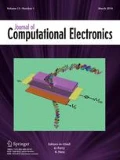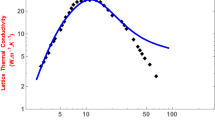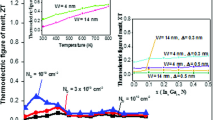Abstract
The correct estimation of the thermal properties of ultra-scaled CMOS and thermoelectric semiconductor devices demands for accurate phonon modeling in such structures. This work provides a detailed description of the modified valence force field (MVFF) method to obtain the phonon dispersion in zinc-blende semiconductors. The model is extended from bulk to nanowires after incorporating proper boundary conditions. The computational demands by the phonon calculation increase rapidly as the wire cross-section size increases. It is shown that nanowire phonon spectra differ considerably from the bulk dispersions. This manifests itself in the form of different physical and thermal properties in these wires. We believe that this model and approach will prove beneficial in the understanding of the lattice dynamics in the next generation ultra-scaled semiconductor devices.
Similar content being viewed by others
References
Buin, A., Verma, A., Anantram, M.: Carrier-phonon interaction in small cross-sectional silicon nanowires. J. Appl. Phys. 104, 053716 (2008)
Buin, A.K., Verma, A., Svizhenko, A., Anantram, M.P.: Significant enhancement of hole mobility in [110] silicon nanowires compared to electrons and Bulk silicon. Nano Lett. 8(2), 760–765 (2008) pMID: 18205425 [online]. Available: http://pubs.acs.org/doi/abs/10.1021/nl0727314
Mingo, N., Yang, L.: Phonon transport in nanowires coated with an amorphous material: an atomistic Green’s function approach. Phys. Rev. B 68(24), 245406 (2003)
Mingo, N., Yang, L., Li, D., Majumdar, A.: Predicting the thermal conductivity of Si and Ge nanowires. Nano Lett. 3(12), 1713–1716 (2003)
Wang, J., Wang, J.-S.: Dimensional crossover of thermal conductance in nanowires. Appl. Phys. Lett. 90(24), 241908 (2007)
Peelaers, H., Partoens, B., Peeters, F.M.: Phonon band structure of Si nanowires: a stability analysis. Nano Lett. 9(1), 107–111 (2009)
Keating, P.N.: Effect of invariance requirements on the elastic strain energy of crystals with application to the diamond structure. Phys. Rev. 145(2), 637–645 (1966)
Sui, Z., Herman, I.P.: Effect of strain on phonons in Si, Ge, and Si/Ge heterostructures. Phys. Rev. B 48(24), 17938–17953 (1993)
Fu, H., Ozolins, V., Alex, Z.: Phonons in GaP quantum dots. Phys. Rev. B 59(4), 2881–2887 (1999)
McMurry, H., Solbrig, A. Jr., Boyter, J.: The use of valence force potentials in calculating crystal vibrations. J. Phys. Chem. Solids 28(12), 2359–2368 (1967)
Weber, W.: Adiabatic bond charge model for the phonons in diamond, Si, Ge, and α-Sn. Phys. Rev. B 15(10), 4789–4803 (1977)
Rustagi, K., Weber, W.: Adiabatic bond charge model for the phonons in A(III)B(V) semiconductors. Solid State Commun. 18, 673–675 (1976)
Markussen, T., Jauho, A.-P., Brandbyge, M.: Heat conductance is strongly anisotropic for pristine silicon nanowires. Nano Lett. 8(11), 3771–3775 (2008)
McMurry, H.L., Solbrig, A.W., Boyter, J.K., Noble, C.: The use of valence force potentials in calculating crystal vibrations. J. Phys. Chem. Solids 28, 2359–2368 (1967)
Zou, J., Balandin, A.: Phonon heat conduction in a semiconductor nanowire. J. Appl. Phys. 89(5), 2932–2938 (2001)
Zhang, Y., Cao, J.X., Xiao, Y., Yan, X.H.: Phonon spectrum and specific heat of silicon nanowires. J. Appl. Phys. 102(10), 104303 (2007)
Li, X., Maute, K., Dunn, M.L., Yang, R.: Strain effects on the thermal conductivity of nanostructures. Phys. Rev. B 81(24), 245318 (2010)
Thonhauser, T., Mahan, G.D.: Phonon modes in Si [111] nanowires. Phys. Rev. B 69(7), 075213 (2004)
Zhao, H., Tang, Z., Li, G., Aluru, N.R.: Quasiharmonic models for the calculation of thermodynamic properties of crystalline silicon under strain. J. Appl. Phys. 99(6), 064314 (2006)
Lazarenkova, O.L., von Allmen, P., Oyafuso, F., Lee, S., Klimeck, G.: Effect of anharmonicity of the strain energy on band offsets in semiconductor nanostructures. Appl. Phys. Lett. 85(18), 4193–4195 (2004)
Hendrikse, Z.W., Elout, M.O., Maaskant, W.J.A.: Computation of the independent elements of the dynamical matrix. Comput. Phys. Commun. 86(3), 297–311 (1995)
Landauer, R.: Spatial variation of currents and fields due to localized scatterers in metallic conduction. IBM J. Res. Dev. 1(3), 223–231 (1957)
Wallace, D.C.: Thermodynamics of Crystals. Dover, New York (1998)
Weinstein, B.A., Piermarini, G.J.: Raman scattering and phonon dispersion in Si and GaP at very high pressure. Phys. Rev. B 12(4), 1172–1186 (1975)
Dongarra, J.: Survey of sparse matrix storage formats, (1995) [online]. Available: http://www.netlib.org/linalg/html_templates/node90.html
Dongarra, J.: Mathworks, Matlab eig reference (2010) [online]. Available: http://www.mathworks.com/help/techdoc/ref/eig.html
Dongarra, J.: Matlab eig reference (2010) [online]. Available: http://www.mathworks.com/help/techdoc/ref/eigs.html
Klimeck, G., Oyafuso, F., Boykin, T.B., Bowen, R.C., von Allmen, P.: Development of a nanoelectronic 3-D (NEMO 3-D) simulator for multimillion atom simulations and its application to alloyed quantum dots. Comput. Model. Eng. Sci. (CMES) 3(5), 601–642 (2002)
Paul A., Luisier, M., Neophytou, N., Kim, R., Geng, J., McLennan, M., Lundstrom, M., Klimeck, G.: Band Structure Lab, May 2006 [online]. Available: http://nanohub.org/resources/1308
Nilsson, G., Nelin, G.: Study of the homology between silicon and germanium by thermal neutron spectrometry. Phys. Rev. B 6(10), 3777–3786 (1972)
Electronic archive, new semiconductor materials—characteristics and properties, Ioffe Physico-Technical Institute Website, 2001, http://www.ioffe.ru/SVA/NSM/Semicond/
Madelung, O.: Semiconductors—HandBook, 3rd edn. Springer, Berlin (2004)
de Gironcoli, S.: Phonons in Si-Ge systems: An ab initio interatomic-force-constant approach. Phys. Rev. B 46(4), 2412–2419 (1992)
Eryiğit, R., Herman, I.P.: Lattice properties of strained GaAs, Si, and Ge using a modified bond-charge model. Phys. Rev. B 53(12), 7775–7784 (1996)
Lazarenkova, O.L., von Allmen, P., Oyafuso, F., Lee, S., Klimeck, G.: An atomistic model for the simulation of acoustic phonons, strain distribution, and Grüneisen coefficients in zinc-blende semiconductors. Superlattices Microst. 34(3–6), 553–556 (2003)
Blackford, L.S., Choi, J., Cleary, A., D’Azevedo, E., Demmel, J., Dhillon, I., Dongarra, J., Hammarling, S., Henry, G., Petitet, A., Stanley, K., Walker, D., Whaley, R.C.: ScaLAPACK Users’ Guide. Society for Industrial and Applied Mathematics, Philadelphia (1997)
Author information
Authors and Affiliations
Corresponding author
Rights and permissions
About this article
Cite this article
Paul, A., Luisier, M. & Klimeck, G. Modified valence force field approach for phonon dispersion: from zinc-blende bulk to nanowires. J Comput Electron 9, 160–172 (2010). https://doi.org/10.1007/s10825-010-0332-9
Published:
Issue Date:
DOI: https://doi.org/10.1007/s10825-010-0332-9




